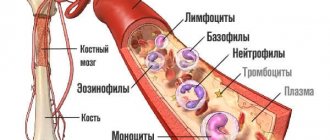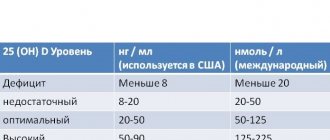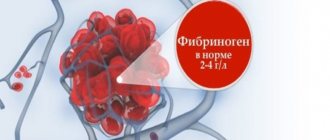Large blood cells from the group of leukocytes are called monocytes. They protect the body from pathogenic microorganisms.
They are called agranulocytic because they do not have granules in the cytoplasm. In addition, they belong to active phagocytes, as they absorb foreign microorganisms and dissolve them.
In addition to destroying viruses, bacteria and fungi, monocytes absorb blood clots, preventing blood clots, and they also have an antitumor effect and accelerate regeneration processes. A decrease in monocytes may indicate the development of anemia, and an increase in their level may indicate infectious diseases.
In the section you will learn everything about monocytes in the blood and about the analysis for them (mon), transcript.
What are monocytes in a blood test?
Monocytes are a type of leukocyte cell, characterized by their large size and lack of granularity.
The main task of monocytic cells is to ensure complete phagocytosis of pathogenic microorganisms, fragments of other leukocytes, malignant and mutated cells.
Monocyte cells have high antimicrobial (antiparasitic, antiviral, antibacterial, antifungal) and antitumor activity.
MON in a blood test may increase if the patient has acute infectious pathologies, multiple myeloma, autoimmune pathologies, etc.
On average, the rate of monocytes in the blood of an adult ranges from three to eleven percent.
The rate of monocytes in the blood does not depend on gender and is determined only by the age of the patient.
How to get it back to normal
Restoring normal monocyte levels is only possible if the underlying disease is treated. Depending on the type of underlying disease, the following remedies can be used.
Medications
In the event that a violation of the monocyte norm is caused by bacterial infections, the following types of medications can be used:
- Erythromycin – a potent antibacterial agent, which is prescribed to take 1-2 tablets 3 times a day 1 hour before or after meals (the course of therapy ranges from 5 to 14 days, and the price of the medication is 75 rubles);
- Amoxil is a penicillin antibiotic, which is prescribed to take 500 mg 2 times a day for 5-7 days (the cost of the drug is 135 rubles);
- Biseptol is an antibacterial and anti-inflammatory drug that is prescribed for most infectious diseases that cause an increase in the level of monocytes (2 tablets are taken 2 times a day with a course of therapy of up to 2 weeks, and the price of the medicine is 175 rubles);
- Amoxiclav-kviktab is a medicine with the active substance in the form of amoxicillin, prescribed to take 1 tablet 2 times a day with a treatment duration of up to 14 days (the cost of the medicine is 250 rubles).
Taking the above drugs is possible only as prescribed by the attending physician, if the strain of the infectious microorganism that provoked the inflammatory process with an increase in the level of phagocytes is identified.
Traditional methods
Folk remedies are not used to reduce or increase the level of monocytes in the blood serum, since they are not able to affect the functionality of the bone marrow, or suppress an acute infectious-inflammatory process.
Other methods
In combination with drug therapy for the underlying disease, which provokes a surge in phagocyte activity, it is recommended to use the following methods that strengthen the immune system:
- long walks in the fresh air;
- dousing with cold water;
- wiping the body with a wet towel;
- taking a course of vitamin-mineral complexes (every 6 months);
- preventive spa treatment of chronic diseases.
The above methods are general strengthening and cannot be used as an independent method of therapy.
General information about monocytes
Monocyte cells are the largest leukocytes. They are an essential component of the specific phagocytic mononuclear-reticuloendothelial system, represented by monocyte and macrophage cells, as well as their precursors.
Normally, monocytic cells circulate in the blood for about twenty to forty hours, and then migrate into tissues, where they are transformed into macrophage cells.
The largest number of monocytic cells is found in the liver, spleen, lung and lymphatic tissues.
The reserve of monocytic cells is contained in the tissues of the lymph nodes.
Monocyte cells actively participate in the formation of the immune response. Due to their high ability for independent movement, these cells are able to quickly move to the inflammatory focus, stimulating the immune response, and also exhibit bactericidal and phagocytic activity.
The main functions of monocytes are:
- phagocytosis of pathogenic microorganisms and mutant cells;
- stimulation of immune reactions;
- presentation of antigens to lymphocyte cells (the function of immune memory is the accumulation and transmission of information about pathogenic agents to the next generations of cells);
- production of cytokines and other biologically active substances (biologically active substances);
- cleansing the inflammatory focus from cell debris and pathogenic microorganisms.
It should be noted that monocytic cells have the ability to actively divide at the site of inflammation, increasing the population of their cells. Also, unlike neutrophil cells, monocytes do not die after contact with pathogenic microorganisms.
In foci of chronic infection, monocytic cells are able to accumulate, helping to maintain the inflammatory process.
Of all leukocyte cells, monocytes have the greatest phagocytic activity. In an inflammatory focus, they are capable of absorbing more than a hundred pathogenic microorganisms.
Due to the cleansing of the inflammatory focus by monocytes, tissues are effectively prepared for further regeneration.
It should be noted that biologically active substances, actively secreted by monocytic cells, are capable of influencing thermoregulatory centers in the hypothalamus, stimulating an increase in the patient’s body temperature in the presence of inflammatory processes in the body.
What it is?
Monocytes are large blood cells, the size of which is up to 20 microns. The cell is oval in shape, with a bean-shaped polymorphic nucleus in the center. The nucleus is brightly colored, which makes it possible to distinguish them from lymphocytes.
Reference! If the body is healthy, the number of monocytes among all white blood cells is 3-11%.
These blood elements can be observed not only in the blood, but also in other tissues of the body, namely:
- in the liver;
- in the bone marrow;
- in the spleen;
- in the lymph nodes.
The synthesis of monocytes occurs in the bone marrow, and their development and growth are influenced by glucocorticosteroids (inhibit) and GM-CSF, M-CSF - cell growth factors (activate).
In the bloodstream, after leaving the bone marrow, monocytes linger for a couple of days, after which they either die or become macrophages. Macrophages enter the tissue and remain active there for 1-2 months.
Reference! Not long ago, scientists came to the conclusion that not all macrophages are improved monocytes; some of them arise during human prenatal development. But monocyte macrophages are the result of a programmed cell life pattern.
Monocytes perform the following functions in the body:
- Phagocytosis is the recognition and capture of foreign elements.
- Formation of immunity and protection of the body from various pathological agents and substances.
- The development of an allergic reaction - they are the ones who synthesize the elements with the help of which the foreign element is recognized.
- Protection of the body from tumor processes is provided by various mechanisms, including necrotic ones.
- Participation in hematopoiesis and blood clotting.
Monocytes, like neutrophils, belong to phagocytes, but they have differences:
- they do not die after absorbing a foreign agent;
- live much longer than neutrophils;
- they fight viruses much more effectively, and neutrophils mainly destroy bacterial flora;
- since they are not destroyed after the absorption of a foreign agent, pus does not form when these cells accumulate;
- as a rule, they accumulate in the focus of chronic inflammation.
Blood test for monocytes
When assessing the level of monocytes, it is necessary to take into account not only the degree of increase in the monocyte cells themselves, but also the total number of leukocytes.
An increased number of only monocytic cells in the leukoformula is called relative monocytosis (and a decrease is called monocytopenia).
An increase in the number of monocytic cells along with the entire population of leukocyte cells is called absolute monocytosis.
Read further: Is it possible to drink alcohol before donating blood for analysis and how many days in advance?
Preparing and conducting analysis
Blood sampling for analysis is carried out exclusively in the morning from 07-00 to 10-00. Biological material is donated on an empty stomach.
During preparation for the study, the following rules will need to be observed:
- do not drink alcohol (24 hours before the test);
- the day before going to the laboratory, do not allow the body to become overtired;
- 48 hours before donating blood, avoid nervous tension;
- the last meal should take place the night before;
- do not smoke on the day of the test.
You must arrive at the blood donation point in advance so that within 10-15 minutes. it was time to rest. Before the test, you are allowed to drink no more than 250 ml of boiled water. Blood sampling is carried out under sterile conditions in a biochemical laboratory. To carry out the analysis, 5 to 10 ml of biological material is sufficient. The results of the study can be obtained in your hands after 2-3 days.
The norm of monocytes in the blood of women by age in the table
The rate of monocytes in the blood of men does not differ.
Normal monocyte levels in women and men by age are presented in the table:
| Patient age | Percentage of monocytes in the analysis |
| First two weeks of life | Five to fifteen |
| From two weeks to a year | Four to nine |
| From one to two years | Three to ten |
| From two to fifteen years | About three to nine |
| More than fifteen years | Three to eleven |
Indications for the study
Monocytes (the norm for women by age, a table of clinical indicators is compiled based on the results of a diagnostic examination of the body) are large leukocytes that play a key role in the full functioning of the immune system.
Direct indications for testing the level of phagocytes are the presence of the following symptoms:
- frequent and unfounded intestinal disorders;
- increased body temperature without obvious signs of inflammation;
- tachycardia and disturbance of the rhythmic activity of the heart;
- dyspnea;
- dizziness and physical weakness;
- rapid fatigue after minor exertion;
- infectious and inflammatory skin diseases;
- chronic diseases of the nasopharynx, upper and lower respiratory tract;
- an allergic reaction that occurs in acute or chronic form.
The need for an analysis for the level of phagocytes in the blood serum is determined by the attending physician, who performs the initial examination of the patient.
Reasons for deviation of monocytes from the norm
An increase in monocytes in the blood can be caused by:
- acute infectious pathologies (usually of viral origin);
- parasitic and helminthic infestations;
- fungal infections;
- subacute infectious processes of bacterial origin (subacute inflammatory processes in the endocardium, rheumatic tissue damage);
- tuberculous lesions of lung tissue and lymph nodes;
- syphilis;
- brucellosis;
- malignant neoplasms;
- UC (nonspecific ulcerative colitis);
- systemic autoimmune pathologies;
- malaria;
- typhus;
- myeloproliferative pathologies;
- oncological blood diseases;
- malignant lymphomas;
- chronic course of herpes virus infection;
- infectious mononucleosis (the main cause of monocytosis in children, in which case monocytosis is combined with the identification of specific atypical mononuclear cells);
- specific monocytic leukemias, etc.
In patients with mycobacterial infections (tuberculosis), a high rate of monocytosis in combination with an increase in the number of neutrophil cells and a decrease in the number of lymphocytes may indicate relapse or progression of the infectious process.
An increase in the number of lymphocyte and monocytic cells against the background of a decrease in neutrophils is typical for recovering patients.
Normally, a slight increase in monocytic cells in women may be observed during menstruation.
Also, an increase in the number of monocytes can be observed in patients undergoing treatment with ampicillin®, griseofulvin®, haloperidol®, prednisolone®, etc.
Read further: What do elevated monocytes in an adult mean?
Reasons for the decline
An insufficient number of monocytes in the blood is observed in severe diseases:
- aplastic anemia;
- purulent bacterial infections;
- late stages of blood cancer;
- when taking certain medications.
Purulent bacterial infections
These are diseases in which the body is affected by pyogenic bacteria, and inflammation begins (streptococcus, staphylococcus).
Purulent bacterial diseases:
- carbuncles;
- boils;
- osteomyelitis;
- sepsis;
- bacterial pneumonia.
A number of purulent infections are capable of self-destruction; some pathologies must be treated after all the necessary studies have been carried out.
Aplastic anemia
Aplastic anemia, unlike other forms of this disease, is accompanied by a sharp stop or complete cessation of the growth and maturation of all blood cells.
Aplastic anemia is accompanied by:
- loss of strength;
- dizziness;
- pale skin;
- tachycardia;
- bleeding;
- development of infectious complications;
- decreased immune functions.
The disease is serious and requires immediate treatment, which consists of chemotherapy, hormone therapy and bone marrow transplantation.
Oncohematological diseases
The late stages of leukemia are a period when all cells of the circulatory system are affected. The patient's immunity decreases, severe infections develop, and bleeding occurs for no reason.
The only treatment for this disease is a bone marrow transplant.
Taking medications
Taking cytostatics and corticosteroids can cause suppression of bone marrow functions, while the concentration of all cells in the blood decreases. If this cause is identified in time and the person is provided with the necessary help, then the functioning of the bone marrow is normalized.
Why does the level of monocytes increase?
A pathological phenomenon in which monocytes exceed the permissible age norm is called monocytosis. It is observed in women suffering from infectious, autoimmune and other dangerous diseases. Quite often, an increase in MON occurs in patients who have suffered a serious illness.
There are two types of monocytosis:
- Absolute. Growth is isolated. MON content – more than 0.8*10 G/l. This phenomenon is typical for diseases that provoke increased formation of phagocytes.
- Relative. The absolute number of MON does not go beyond the normal range, but their percentage in the blood increases. A similar phenomenon is observed when the level of other 4 types of leukocytes (neutrophil, lymphocyte, eosinophil, basophil) simultaneously decreases.
It is believed that absolute monocytosis is more dangerous, since it is this that signals dangerous problems in the body. If MON has increased, it means that the body has launched an immune defense aimed at fighting pathogens.
All causes of elevated MON levels are divided into physiological and pathological. The first include conditions associated with a woman’s physiology – pregnancy and menstruation. Pathological causes include diseases of various natures.
Menstruation
In women, an increase in MON is recorded in the first days of the menstrual cycle. At this stage, the endometrium is actively rejected, to which the main “orderlies” of the body – monocytes and macrophages – actively respond. They need to restore order in the female body, which they successfully cope with.
The maximum number of monocytes occurs on the days when the discharge becomes most abundant. When the bleeding ends, the content of phagocytes returns to normal.
Attention! Although MON levels do not leave the maximum range during menstruation, doctors do not recommend taking a test until the discharge stops.
Pregnancy
During pregnancy, the body undergoes restructuring, so it is necessary to constantly monitor the composition of the blood. A woman’s body is preparing for the fact that it will have to provide “building material” and nutrition to the developing fetus.
As a result, MON levels drop already in the first trimester of pregnancy. The lower limit is 1% instead of 3%. Over time, the situation changes - the number of monocytic cells increases. The maximum occurs with the arrival of the third trimester.
Parasites
Increased activity of phagocytes occurs during helminthic infestations. If pinworms, roundworms or some other helminths have settled in the body, monocytes increase.
Characteristic symptoms will help you guess the presence of parasites:
- uneven stool – usually it results in diarrhea;
- increased appetite and weight loss;
- abdominal pain;
- rashes similar to hives.
When infected with parasites, along with MON, the growth of another type of leukocyte – eosinophils – is recorded in the blood. These cells are responsible for allergic reactions.
Tuberculosis
This severe infection affects not only the lungs; the skeletal system, skin and organs of the genitourinary system can be affected. With tuberculosis, prolonged fever, lethargy, fatigue, and weight loss are observed.
With pulmonary tuberculosis, there is a constant, persistent cough. Fluorography helps to identify it. To diagnose other types of tuberculosis, it is necessary to undergo other special tests.
In the CBC of blood in patients with tuberculosis, the deviation concerns not only MON, but also other indicators. Monocytes increase, but other indicators decrease.
Acute infections
Any infectious disease leads to the growth of monocytes. In acute respiratory viral infections, MON in the CBC slightly exceeds the permissible value.
During bacterial attacks, the number of neutrophil leukocytes will increase, and during viral attacks, the content of monocytes will increase. Thus, the nature of the disease can be immediately seen from the CBC.
Features of increased MON in infectious diseases:
- the concentration increases from the first days of the viral disease and remains high until complete recovery;
- even when symptoms subside, monocyte levels remain above normal for another 2 weeks;
- if after 1.5-2 months the monocytic analysis does not return to normal, it means that there is a chronic infection in the body.
For common colds, which doctors call acute respiratory infections, the increase is small. It usually barely goes beyond the upper limit of normal, and amounts to 0.09-1.5 * 10 G/l.
A jump in MON can also be observed with measles, rubella, and whooping cough. Today, adults are not immune from so-called “childhood” diseases.
Infectious mononucleosis
This disease is caused by a herpes-like virus. It is usually experienced during childhood. Those unlucky enough to have it may catch it later. True, this happens very rarely, since the immunity of adults is more resistant to this virus. In the CBC, not only monocytes, but also lymphocytes are elevated.
Autoimmune problems
These are conditions in which the immune system begins to perceive its tissues as foreign, destroying them. Monocytes and macrophages immediately rush into battle to destroy the “outsiders.” A low rate is recorded in patients suffering from rheumatoid arthritis, diabetes mellitus, and systemic lupus erythematosus.
Elevated monocytes in autoimmune diseases are the main clinical sign. Having discovered monocytosis, studies are immediately carried out, during which the above pathologies can be identified.
What does the increased level indicate?
If monocytes are elevated, the disease is called monocytosis. When there are elevated monocytes in the blood, this indicates the presence of foreign agents in the blood, which may indicate the development of neoplasms and infections.
Let's take a closer look at what this means - increased monocytes in the blood. This phenomenon can develop against the background of a number of diseases, so such signs should never be ignored:
- This may indicate the development of tuberculosis.
What should their level be?
We looked at what monocytes are in a blood test, now it’s time to figure out what their indicator is normal. Since these cells are one of the types of leukocytes, their measurement involves determining the percentage of monocytes in the number of leukocytes.
Important! This indicator is absolutely independent of gender or age differences, and therefore the norm of monocytes in women and men is at the same level. There are only slight differences by age and during certain periods of pregnancy.
A short video about the purpose and properties of monocytes
The normal content of these cells is as follows:
- At the age of 10 years it ranges from 2 to 12%.
- Upon reaching 12 years of age - 3-10%.
What does the decreased
If monocytes are low, the disease monocytopenia is diagnosed, against which anemia can develop and the level of other blood elements sharply decreases.
Folate deficiency anemia and aplastic anemia are the two most common causes of low monocyte levels. Monocytopenia is also one of the most common symptoms of treatment with glucocorticoid-type drugs.
Normal (left) and decreased levels of monocytes in the blood
Important! If segmented monocytes are completely absent from the blood, then this is a very bad sign. Most often we are talking about a severe form of leukemia, in which the production of monocytes stops. Sepsis may also be the cause, when there are not enough monocytes to cleanse the blood and blood cells are destroyed as a result of exposure to toxins.
Thus, serious health problems can occur with both increased and decreased levels of monocytes in the body. Therefore, if you suspect any problems in this area, you should immediately consult a doctor.
For various diseases and for screening purposes, doctors often prescribe a general blood test. One of its important indicators is monocytes. What is the normal range of these cells in men?
Treatment
The role of mononuclear cells of this type in protecting the body from the effects of various harmful factors is so great that the treatment of monocytosis and monopenia is an urgent task of any therapy. First of all, a complete and comprehensive examination of the patient is necessary to determine the cause of the pathology of leukocytes. Treatment must begin with the underlying disease.
In diseases of internal organs, reactive monocytosis that occurs in response to endogenous influences, the effectiveness of treatment of leukocyte pathology is determined by the results of therapy for the underlying disease. A much more complex problem is monoblastic leukemia. At the first stage of treatment, it is necessary to achieve remission. Cytarabine is used, a drug with a targeted anti-leukemia effect, administered intravenously. Doxorubicin, Etoposide are antitumor drugs that are used as monotherapy and in combination with other drugs. After achieving remission, a bone marrow transplant is possible.
A low content of cells of this type in the blood leaves the body without protection, so treatment for monopenia begins immediately, before its causes are clarified. Diet No. 11 is prescribed, with a high protein content, limited salt and sugar, and a high content of vitamins. After clarifying the underlying disease, targeted treatment is carried out.
A change in the number of leukocyte elements in the direction of decreasing or increasing their number is a dangerous condition, indicating severe pathology and the absence of a sufficiently tense immune system. Timely diagnosis and medical advances in the field of hematology make it possible to treat diseases of the hematopoietic system, monocytosis and monopenia of various etiologies, reduce treatment time, and return patients to health.











